Depending on whom you ask or what kind of lacquer you're referring to, the precise definition of lacquer may vary. Read about it to learn about the different types, how it's created, and how it's different from other finishes like polyurethane and varnish.
What Is Lacquer Paint?
It is a liquid consisting of shellac soaked in alcohol that, when applied to materials like wood and metal, dries to form an extremely hard, smooth, protective covering. It can be constructed of synthetic materials in addition to the sap of a certain tree, from which it was originally made. PEDINI Miami employs quality lacquer in their collections for modern houses since it is well-liked for furniture and is incredibly resilient to damage.
According to doityourself.com, nitrocellulose, plasticizers, and pigments are all dissolved in volatile solvents to create lacquer, which is a solvent-based product. Additionally, a synthetic coating and high-gloss surface are produced using an alcohol and shellac solution.
So what exactly is shellac if it's used to make lacquer? One of the most intriguing materials to read about in the field of furniture finishing is shellac. A material made from bugs is the source of shellac! Yes, shellac is created from the cocoon-like excretions of the "lac" (Laccifer lacca), a little parasitic bug that feeds on specific Asian trees. But what purpose does this stuff serve?
For lacquer furniture and automobiles, a lacquer-based paint was popular from the 1920s until the 1960s. This kind of paint is delicate and doesn't have a lot of chemicals in it. It was not strong or long-lasting and could require up to six coats to finish an auto body. Today, the only place that this type of lacquer paint is used is in furniture manufacturing shops.
What Advantages Do Cabinets With Lacquer Paint Have?
Lacquer has recently become a favorite for homeowners who want to remodel their kitchens and have a glossy finish on cabinets. Lacquer looks like new for a long time and is extremely durable as it’s chip-resistant and waterproof. If it does show wear over time, it can be polished to resume a high sheen, or it can be applied in more matte options and a wide variety of colors. For an idea of some lacquer finishes in kitchens, visit the PEDINI Miami Kitchen collections to learn more about the use of lacquer in our full turnkey projects. Currently, PEDINI Miami offers lacquer paint for cabinets finishes with their most popular collections, including:
- Artika
- K016
- Arke
- Arts Crafts
- Moka
- Eko
- Materika
- Dune
How Lacquer Paint Is Applied
Spray lacquers like those from Rust-Oleum in clear, gloss white, and gloss black give metal and wood surfaces an extremely durable, factory-finish appearance. However, it should be done professionally for the greatest outcomes.
What Are Some Different Types of Lacquer?
Nitrocellulose Lacquer
The most popular kind of lacquer is this one. It is frequently applied on timber goods. As it ages, this kind of lacquer tends to turn yellow. It does not perform well in outdoor settings since it can crack with aging or temperature changes. This sort of lacquer is dangerous since it is combustible and extremely poisonous.
Acrylic Lacquer
For usage on automobiles, acrylic-based lacquer was created in the 1950s. For lighter-colored wood, it is frequently chosen because of its non-yellowing formula and extremely quick drying time.
Water-Based Lacquer
Kitchen cabinet refinishing is now a common practice using water-based lacquers. Compared to many lacquers, it is more environmentally friendly while still being tough and scratch-resistant.
Metal Lacquer
Wider temperature swings are not expected to cause metal lacquer to fracture. It can therefore be used for both indoor and outdoor applications. It can be used on unglazed ceramic, metal, wood, and masonry. It is the kind utilized in contemporary autos and is quite durable.
Takeaway
For wood, metal, and home furniture, the options for finishes are essentially endless. If you live in a luxurious house, it's a good idea to let an interior designer lead you through the minefield of choosing the best surfaces for your turnkey interior design project.








